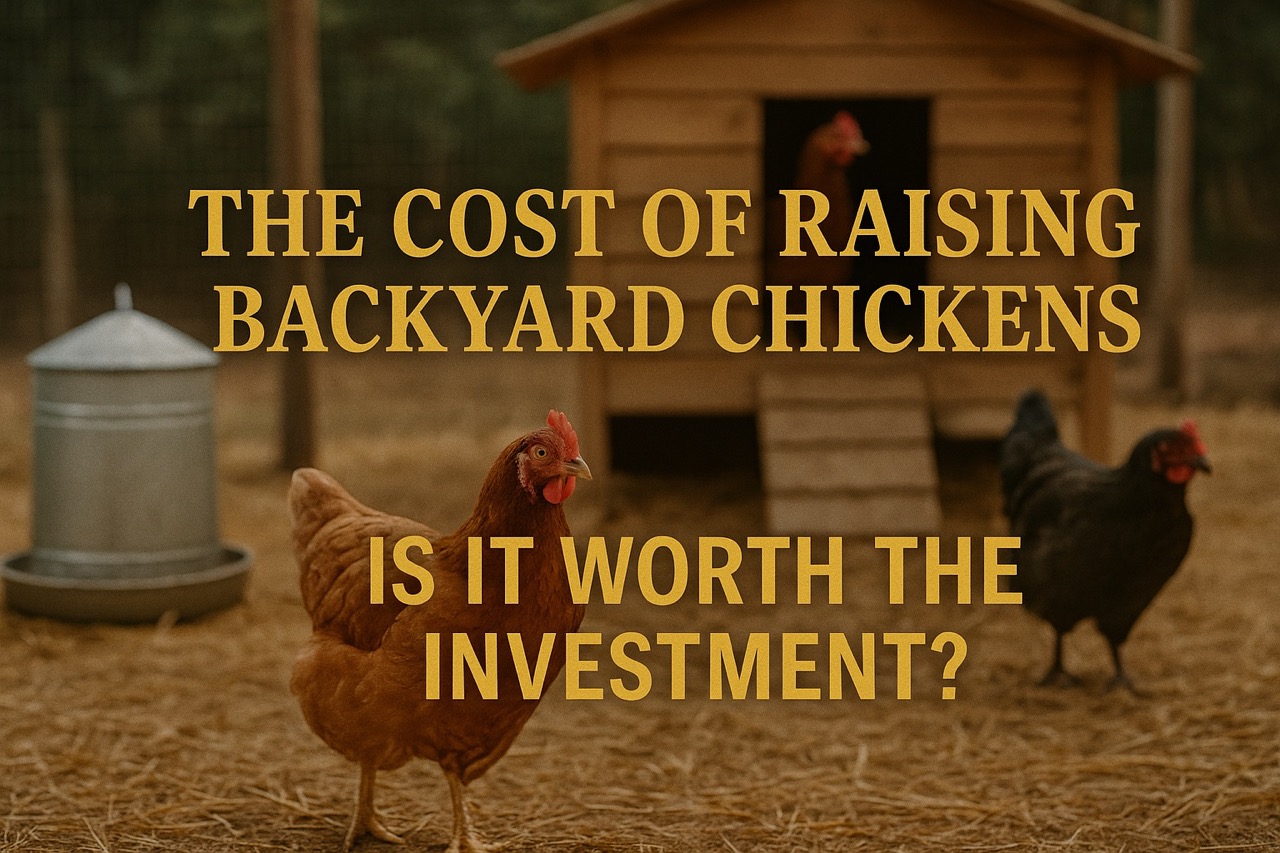Raising backyard chickens is a rewarding experience, but it’s essential to understand the true cost before you begin. While the benefits of fresh eggs, natural pest control, and sustainability are enticing, knowing the upfront and ongoing expenses will help you make an informed decision. This guide breaks down the financial realities of raising chickens, from coop costs to feed and maintenance, so you can determine if the investment fits your lifestyle and budget.
📅 Initial Costs of Raising Backyard Chickens
Coop and Run Setup
- Pre-Made Coops: $300–$1,000 depending on size, material, and insulation.
- DIY Coops: $100–$300 using recycled materials.
- Chicken Run: $100–$500 for secure fencing.
Insight: Plan for at least 2–3 sq ft per chicken inside the coop and 8–10 sq ft in the run. Overcrowding can lead to stress, disease, and lower egg production.
Feeders and Waterers
- Basic Setups: $20–$50 each.
- Automatic Systems: $75–$150 for time-saving, no-spill options.
Tip: Automation helps reduce labor and prevents food waste.
Bedding and Nesting Boxes
- Straw or Pine Shavings: $5–$10 per bale; monthly replacement needed.
- Nesting Boxes: $10–$50 per box (one box for every 3–4 hens).
Note: Avoid cedar—its strong oils can irritate your flock’s lungs.
Chicks vs. Pullets
- Chicks: $3–$5 each, but require a brooder and heat source.
- Pullets: $15–$25 each, already near egg-laying age.
Beginner Tip: Start with hardy breeds like Buff Orpingtons or Rhode Island Reds.
Brooder and Heat Lamp
- Heat Lamp: $15–$25.
- Brooder Setup: $20–$50 (plastic bin or cardboard box works).
Reminder: Chicks need 95°F their first week, reducing 5° per week after.
🌾 Ongoing Costs of Backyard Chickens
Feed Costs
- Bag of Feed (50 lbs): $15–$25.
- Daily Consumption: 1/4 lb per chicken; one bag lasts 4–6 weeks for 4–6 hens.
Savings Tip: Supplement with garden scraps, free-ranging, or forage crops.
Bedding Replacement
- Monthly Cost: $5–$15 depending on coop size.
- Deep Litter Method: Saves on bedding and provides winter warmth.
Health Care
- Supplements & Grit: $20–$50 per year.
- Vet Visits: $50–$200 if needed for illness or injury.
Prevention Tip: Clean your coop weekly and supply oyster shell or grit to aid digestion and egg strength.
Utilities
- Water: Negligible, but must be fresh daily.
- Electricity: $10–$20/month in winter for heat or lighting.
Eco Option: Use solar lighting to maintain winter egg production.
⚠️ Unexpected Expenses
Predator Protection
- Upgrades (Hardware Cloth, Electric Fencing): $50–$200.
Insight: Don’t rely on chicken wire alone. Raccoons and foxes can tear through it.
Repairs & Maintenance
- Annual Estimate: $50–$100.
- Common Issues: Leaks, rusted hardware, or weather damage.
Pro Tip: Routine maintenance extends your coop’s lifespan significantly.
💸 Cost Summary for a Flock of 4–6 Chickens
- Startup Costs: $300–$1,500
- Yearly Feed & Care: $200–$400
- Unexpected Costs: $50–$200/year
🍳 The Value of Backyard Chickens
Financial & Practical Benefits
- Egg Production: 200–300 eggs per hen/year → major grocery savings.
- Pest Control: Chickens eat ticks, grubs, and garden pests.
- Fertilizer: Chicken manure enhances compost and garden soil.
- Waste Reduction: Turn kitchen scraps into eggs!
Is It Worth It?
If you value sustainability, self-reliance, and daily access to fresh eggs, backyard chickens are a smart long-term investment. While not the cheapest hobby, the return in food, fun, and environmental benefits is high.
🧥 Final Thoughts
The cost of raising backyard chickens isn’t just financial—it’s about lifestyle. When managed well, chickens pay dividends in fresh food, reduced waste, and joyful animal companionship. With realistic expectations and smart planning, the investment can absolutely be worth it.
Ready to start your flock? Know the numbers and build your coop with confidence.
Sources and Related Reading
For a comprehensive understanding of the financial aspects of raising backyard chickens, consider the following resources:
- “How Much Do Chickens Cost?”
Backyard Poultry Magazine
This article provides a detailed breakdown of the initial and ongoing expenses associated with keeping chickens.
Read the article here - “How Much Does It Cost to Raise Chickens for Eggs?”
Mother Earth News
An analysis of the costs involved in raising chickens for egg production, including feed and infrastructure expenses.
Explore the guide - “The True Cost of Raising Chickens for Eggs”
Morning Chores
This resource compares the expenses of raising chickens to the cost of purchasing store-bought eggs, helping you assess financial viability.
Learn more - “Beginner’s Guide to Raising Backyard Chickens”
The Happy Chicken Coop
A comprehensive guide for newcomers, offering budgeting tips and cost-saving strategies for starting your own flock.
Visit the article - “Chicken Economics: The Cost of Keeping Chickens”
Mother Earth News
An exploration of the economic considerations of chicken keeping, including hidden costs and long-term investments.
Read the article here
These articles provide valuable insights into the financial commitments involved in raising backyard chickens, aiding you in making informed decisions.
🐓 More Reading on Paranoid Prophet
• Best Chicken Coop Bedding: A Complete Guide
Explore the pros and cons of popular bedding types like hemp, straw, and pine shavings to keep your chickens clean, comfortable, and healthy.
• How Many Chickens Should You Start With?
Starting your first flock? Learn the ideal number of birds for beginners, coop space requirements, and how to scale responsibly.
• What Not to Feed Chickens: Common Mistakes and Hidden Dangers
Avoid costly mistakes! This guide breaks down toxic foods, drinks, and plants that could harm your flock—and what to offer instead.
FAQ: Cost of Raising Backyard Chickens
1. How much does it cost to start raising backyard chickens?
The initial cost of raising backyard chickens varies based on your setup. Expect to spend:
- Coop: $200–$1,000 (or less if DIY).
- Run: $100–$500.
- Feeders and waterers: $20–$50 each.
- Chickens: $3–$25 per bird, depending on age and breed.
- Total initial costs: $300–$1,500, depending on your choices.
2. How much does it cost to feed chickens monthly?
On average, a single chicken eats about 1/4 pound of feed per day. A 50-pound bag of feed costs $15–$25 and lasts 4–6 weeks for a small flock of 4–6 chickens. Monthly feed costs for a small flock are around $20–$40.
3. Are there any unexpected costs with raising chickens?
Yes, unexpected expenses may include:
- Predator-proofing ($50–$200 for materials like hardware cloth or fencing).
- Veterinary care ($50–$200 per visit).
- Coop repairs or upgrades ($50–$100 annually). Planning for these costs ensures you’re prepared for emergencies.
4. Can raising backyard chickens save money in the long run?
Raising chickens can save money on eggs, especially with consistent egg-laying breeds. A flock of 4–6 hens can produce 800–1,800 eggs annually, reducing grocery bills. However, the initial setup costs mean it could take a few years to break even. Non-monetary benefits like fresh eggs, pest control, and sustainability often make it worthwhile.
5. How can I reduce the cost of raising chickens?
Here are a few cost-saving tips:
- Use recycled materials to build a coop.
- Feed chickens kitchen scraps or allow them to free-range to reduce feed costs.
- Use deep litter bedding methods to save on cleaning materials.
- Start with pullets instead of chicks to skip brooder setup costs.
6. What breeds are the most cost-effective to raise?
For beginners and those looking for maximum egg production, consider breeds like:
- Rhode Island Reds: Hardy and prolific layers of 250–300 eggs per year.
- Leghorns: Produce up to 320 eggs annually with lower feed consumption.
- Australorps: Reliable layers with excellent temperament. These breeds offer great returns on your investment.
7. Do I need electricity in my coop, and how much does it cost?
Electricity is needed for:
- Heat lamps (if raising chicks or in cold climates).
- Lighting to maintain egg production during shorter winter days. Costs for electricity range from $10–$20 per month, depending on usage and climate.
8. Are there grants or subsidies available for raising backyard chickens?
Some cities or local governments offer grants or rebates for urban farming or sustainable living projects, which could include chicken coops or predator-proofing. Check with your local agricultural office or sustainability programs for options.
9. How can chickens help reduce other household costs?
Chickens provide several cost-saving benefits:
- Reduce food waste by eating kitchen scraps.
- Produce nutrient-rich manure, reducing the need to buy garden fertilizers.
- Naturally control pests like insects and weeds, lowering pesticide costs.
10. What are the long-term costs of raising chickens?
Long-term costs include:
- Feed and bedding: $200–$400 annually for a small flock.
- Maintenance and repairs: $50–$100 annually.
- Healthcare: $20–$50 per year for basic supplements and deworming. Overall, expect ongoing expenses to average $300–$600 annually for a 4–6 chicken flock.




